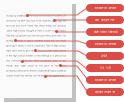GRE Argument 写作范文
The following appeared in a memo written by a dean at Buckingham College:
"To serve the housing needs of our students, Buckingham College should build a new dormitory. Buckingham's enrollment is growing and, based on current trends, should double over the next fifty years, thus making existing dormitories inadequate. Moreover, the average rent for an apartment in our town has increased in recent years. Consequently, students will find it increasingly difficult to afford off-campus housing. Finally, an attractive new dormitory would make prospective students more likely to enroll at Buckingham."
Write a response in which you discuss what specific evidence is needed to evaluate the argument and explain how the evidence would weaken or strengthen the argument.
In this memo a dean at Buckingham College recommends that in order to meet expected enrollment increases the college should build an additional dormitory. To support this recommendation the dean points out that rental rates for off-campus apartments have been increasing, thus making it more difficult for students to afford this housing option. The dean also points out that a new dormitory would attract prospective students to the college. This argument is problematic in several respects.
A threshold problem with the argument involves the statistical reliability of the reports about off-campus rental rates. The dean indicates only that "student leaders" reported these statistics; the dean provides no information about how these students collected their data. It is entirely possible that the report was based on an insufficiently small sample, or a sample that was unrepresentative of the town's overall student rental market.
Secondly, the dean assumes that this current trend in rental rates will continue in the future; yet the dean offers no evidence to substantiate this assumption. These rates are a function of supply and demand, and it is entirely possible that construction of apartment houses will increase in the future, thereby reducing rental rates along with the need for an additional dormitory. Without considering this possible scenario, the dean cannot justifiably conclude that an additional dormitory is needed to meet future demand.
Thirdly, the dean assumes that as enrollment increases the demand for student housing will also increase. While this might be the case, the dean ignores the possibility that the increased enrollment will be the result of an increase in the number of students commuting to Buckingham from their parents' homes. This scenario, if true, would render the dean's argument for building a new dormitory untenable.
Yet another problem with the argument involves the dean's final claim that an attractive new dormitory would attract prospective students to Buckingham. Even assuming students in fact choose colleges on this basis, by relying on this evidence the dean essentially provides an argument against building the new dormitory. If an attractive new dormitory would increase demand for dormitory space, this fact would only serve to undermine the dean's conflicting claim that the new dormitory would help meet increasing demand for dormitory space.
In conclusion, the dean's recommendation is not well supported. To strengthen it the dean must provide clear evidence that average rental rates for off-campus student apartments have in fact been increasing, that this trend will continue in the future, and that this trend will in fact result in an increased demand for dormitory housing.
批改及润色体验馆 想知道您的作文、口语、文书将如何被我们的专家批改及润色吗? 查看更多
 马上体验口语批改
马上体验口语批改
 马上体验作文批改
马上体验作文批改
 马上体验文书润色
马上体验文书润色
作文题库:
托福-综合写作 托福-独立写作 雅思-小作文 雅思-大作文 GRE-Issue GRE-Argument GMAT-Argument SAT-Essay ACT-McGraw-Hill ACT-历年代表性作文题目考研-小作文 考研-大作文 四级-作文 六级-作文 专四-大作文 专四-小作文 专八-作文 高考-新课标一 高考-新课标二 高考-北京 高考-天津 高考-广东 高考-四川 高考-辽宁 高考-安徽 高考-福建 高考-湖南 高考-湖北 高考-陕西 高考-浙江 高考-山东 高考-上海 高考-重庆 高考-江苏 高考-江西 高考-杭州外国语学校 高考-郑州四中 高考-章丘
口语题库:
托福-Question 1 托福-Question 2 托福-Question 3 托福-Question 4 托福-Question 5 托福-Question 6 雅思-Part 1 雅思-Part 2 雅思-Part 3求职面试-500强企业高频通用英文面试题目100道 求职面试-各大企业常用场景英文面试题目
签证面签-你是谁 签证面签-你去做什么 签证面签-你有能力去做吗 签证面签-你会回来吗
留学面试-关于学校及专业 高考-高考口语
文书润色:
留学文书 学术论文 商务文书 求职文书 课程作业 书稿润色 学术论文试用 学术论文摘要大家刚刚提交了...
- 雅思作文:自定义题目
- 签证面签口语:关于学位Question 2
- 托福口语:自定义题目
- 专八作文:自定义题目
- 托福口语:黄金口语80题 Topic 14
- 雅思作文:自定义题目
- 四级作文:自定义题目
- 托福作文:2014年04月19日 独立写作题目
- 雅思作文:自定义题目
- 雅思作文:自定义题目
- 托福作文:2012年03月18日 独立写作题目
- 雅思作文:自定义题目
- 日常练习作文:第25题
- 雅思口语:雅思口语机经题目库 Part 3 - A famous person Question 3
- 高考作文:自定义题目
- 高考作文:自定义题目
- 托福作文:2013年11月09日 独立写作题目
- GRE作文:自定义题目
- 托福口语:Delta备考策略与模拟试题 Quiz 5 口语 Question 3
- 托福作文:自定义题目
专家建议练习方案 查看详情

使用有问题?请联系我们的在线专家
工作时间:09:00AM - 08:00PM
 专家在线
专家在线





